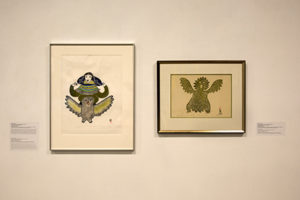Fifth Parallel Gallery, Dr. William Riddell Centre
May 23rd – June 6th, 2018

Pitseolak Ashoona (1904-1983), Young Woman and Owl (27/50), 1979, stonecut stencil on paper. University of Regina President’s Art Collection, Shumiatcher Donation. Gift of Dr. Morris C. Shumiatcher, O.C., S.O.M., Q.C. and Dr. Jacqui Clay Shumiatcher, S.O.M., C.M., 2017; sc.2017.01. Pitseolak Ashoona (1904-1983), Joyful Owl (10/50), 1961, stonecut on laid japan paper. University of Regina President’s Art Collection, Shumiatcher Donation. Gift of Dr. Morris C. Shumiatcher, O.C., S.O.M., Q.C. and Dr. Jacqui Clay Shumiatcher, S.O.M., C.M., 2017; sc.2017.27. © Pitseolak Ashoona. Reproduced with the permission of the Dorset Fine Arts. Photograph by the University of Regina.
This exhibition provides a rare opportunity to view a selection of Inuit artworks on paper, recently donated to the University of Regina by Drs. Morris (1917-2004) and Jacqui Shumiatcher (b. 1923). While Morris and Jacqui are two individuals synonymous with Inuit sculpture, they also amassed a collection of Inuit works on paper, which Morris described as “pictures of joy framed within the thin margins that draw so precarious a line that separates the living from the dying”.
The collection began with the purchase of two prints from the first exploratory print collection published in Cape Dorset (Kinngait) in 1958. Inuit printmaking began at this time with a collaboration between a small group of artists (of which Eegyvudluk Pootoogook, Lukta Qiatsuk, Iyola Kingwatsiak, displayed here, were members) and Northern Service Officer, James Houston. Recognising the artistic talent of local sculptors and carvers, Houston facilitated the production and promotion of Inuit art. With Houston came technical printmaking skills learned in Japan, and at the urging of Oshweetok Ipeelie, the fledgling West Baffin Eskimo Co-operative was established. The prints produced therein, reliefs cut from stone and sealskin stencils, innovatively translated graphic and storytelling traditions to a new medium.
The works on display continue the chronology of the early printmaking evolution, with key examples of work from the 1960 and 1961 annual portfolios. The distinct styles of these printmaking pioneers feature Eegyvudluk Pootoogook’s anthropomorphic totem and Parr, Kiakshuk and Pudlo Pudlat’s emergent monochromatic prints. Kenojuak Ashevak’s remarkable Enchanted Owl (1960) is not only one of the celebrated Cape Dorset icons, but is displayed here in rare drawing form. The Shumiatcher donation also includes a small representation of work from several other northern co-operatives. Steeped with the artist’s dreams, memories, stories, beliefs and the poetry of everyday life, Stonecuts and Sealskins shares a fragment of the vocabulary of the north.
For more information on Indigenous art at the University of Regina, click here
For more information on the Shumiatcher Donation, click here


